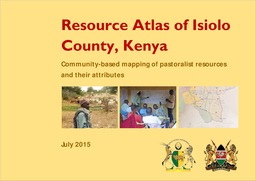Resource information
Participatory digital mapping using satellite imagery and digital earth and other open source Geographic Information Systems (GIS) is a practical tool bridging the knowledge and communication gap between pastoral communities and county government planners. It is offering an effective option for participatory planning and decision-making in support of climate change adaptation in the drylands of Kenya.
These maps are typically drawn on the ground using stones, bits of wood and other easily available material to depict key features such as schools, water points, forest areas, etc. Such processes produce perception maps rich in local knowledge and reflecting community priorities. From the perspective of government planners, however, such maps are of limited use for planning as they lack accurate scales and coordinates – characteristics essential for demarcating the location and extent of resources on which to develop byelaws for their protection and good management.
The process used in Isiolo County combines digital mapping with community-drawn perception maps. While fully capturing the wealth of local knowledge, they contain a built in coordinate system which respond to a global reference grid, enabling their linkage to maps used in formal systems. The coordinate system provides a geographically precise basis from which to discuss natural resource management, making outputs of participation in mapping more universally useable.
These benefits, need to be carefully balanced to avoid the risk that through this process pastoral resources, that are highly dynamic, are ‘frozen’ in time and space. The flexible nature of digital maps allows users to zoom in and work on specific areas, and then to zoom out to obtain a wider view of the data. This is critical when developing maps of pastoral resources and livelihood strategies that require a presentation of data and analysis at the ecosystem scale, reflecting the dimension at which the system operates.

